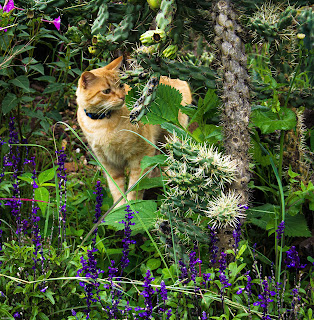Who's afraid of Mickey Mouse?
Stew and I believe gray mice are endearing. And apparently so did The Walt Disney Company, who's made billions off Mickey and Minnie, and also Remy, the protagonist of Disney•Pixar's 2007 animated feature "Ratatouille," about an irresistibly charming Parisian rat who aspires to become a chef.
A lot of people are unpersuaded by the charm of rodents, starting with our housekeeper Rocío, a normally sane woman who freezes at the sight of a mouse, particularly a live one. She will summon me, Stew, the gardener or any other male around and cease her chores until someone removes the tiny corpse, or chases the live mouse out of the house.
Rocío's alarums become more frequent during the winter when mice seek shelter inside. There's no point explaining to her that a two- or three-inch mouse poses no threat to a human who, from a mouse's viewpoint, must look as colossal as the Statue of Liberty.
This year mouse incursions have increased since we installed a pet entrance, a little flapper gizmo, about 8 by 5 inches, so our three cats can get in and out of the house at will. Since then, and combined with colder temperatures, tiny grey mice have been appearing in our bedroom almost daily: Cats are not content to just catch a mouse, but feel obligated to ostentatiously bring it to you as a ritual offering, proof that they're earning their keep.
 |
| Prime suspect. |
If the victim is dead, it'll appear on the rugs by the sides of the bed or in the bathroom. If still alive, their presence will be known by the banging and crashing of things around the bedroom early in the morning, the sounds of a cat still in hot pursuit.
We've narrowed down the feline assassin. It's our orange three-year-old tomcat Fred. Even after neutering he still exhibits the traits of the species Gatus mexicanus mucho macho. He briefly stops by our bed for a piece of cheese at night and then struts through the trap door to spend the night outside, terrorizing the wildlife.
Fifo, our fifteen-year-old tomcat is too old to waste time on such frivolity. Every morning he just goes outside through the trap door and circles the house once, maybe twice, and then returns to sleep or stand by some window and pensively gaze at the world outside as if mentally editing his memoirs.
Our third feline, Franny, Fred's sister, is too prissy and timid to chase mice. She has blue eyes and a gorgeous coat of gossamer fur. Aside from sleeping and eating, she just poses, as if waiting for her imminent closeup.
 |
| Who doesn't love a vole? |
Scientific studies attest to the affection rodents, in one case voles, which are quite affectionate towards one another. Another article speaks about how mice and rats bond with their families and even humans.
 |
| Stew's own mouse trap. |
Aside from chewing up cardboard and fabric as material to build their nests, I find gray mice rather harmless.
I'll grant you, there was that unfortunate bubonic plague contretemps in Europe during the 14th Century, which killed an estimated 25 million people.
The fake news media of the time unfairly blamed mice that came aboard ships from Asia even though, more precisely, it was the lice on the mice that carried the dreaded plague.
Nowadays, the U.S. Centers for Disease Control reports only a handful of cases of bubonic plague, and no deaths, so we should all lay off mice on that account.
To help calm Rocío's nerves, Stew has developed a most humane mouse trap. He puts a plastic cottage cheese carton on the mouse and then slips a piece of carboard underneath. Then he relocates it outside.
Gentle as that trapping may seem, I can't bring myself to do it. Instead I yell for Stew and point at the mouse, pretty much like Rocío does.
My excuse is that I don't want to hurt the mouse with some clumsy moves. But the truth may be far more embarrassing: Am I afraid of those cute little mice too?

Comments
Post a Comment
Let us hear your opinions, thoughts and comments